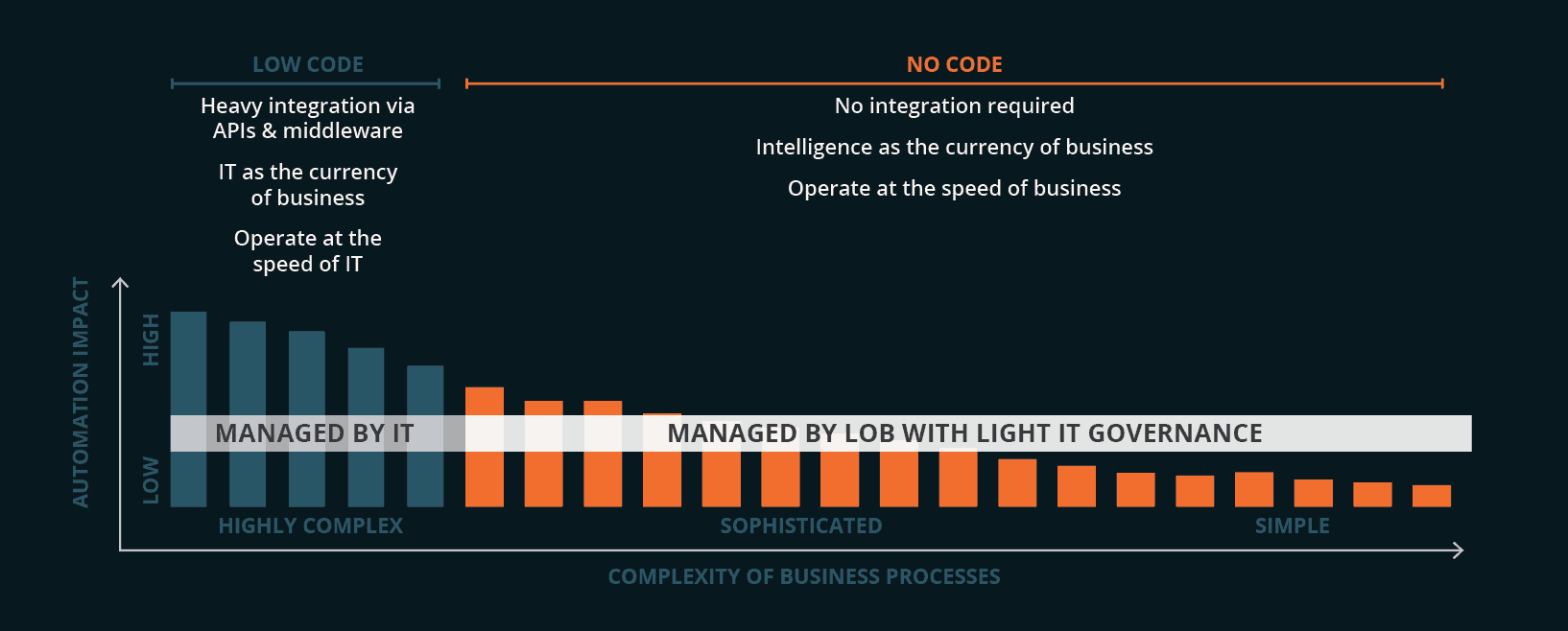Over the past few decades, computing technology has transformed the way we conduct business. Automating once manual business processes has enabled employees to work more effectively and efficiently. These technological advances have evolved like chapters in a book – commonly classified as “waves.”
Industry analysts identified the first of these waves as Business Process Management (BPM) – software that works to route large amounts of structured data quickly and securely. Automation capabilities have developed dramatically since then, evolving to Business Process Automation and to the third wave: Workflow and Content Automation (WCA). WCA combines no-code workflow capabilities, document generation, and process analytics to help accelerate business outcomes by eliminating manual processes and paper.
Nintex, the recognized global leader in WCA, is proud to usher in the fourth wave of process automation – known as Intelligent Process Automation (IPA), which helps enterprise organizations improve business processes by leveraging new capabilities in intelligence like AI, machine learning, and natural language processing.

A Look Back
Traditional BPM solutions are the basis from which process automation technology has developed.
BPM was born from data (and lots of it).
Late last century, BPM changed the way we thought of transactional processes and how they were handled. It improved company performance by managing and routing data into a database quickly, accurately, and securely through a structured process.
BPM is a systematic approach to improving essential, company-wide, and high-profile processes, and it remains still very much relevant in today’s market. But it is not without its limitations. BPM solutions are typically complex, rigid, and demand significant time and development resources to build and deploy. Each solution requires a lengthy and expensive procedure before implementation – starting with analysts and solutions architects to define and model the process and ending when software developers built and deployed the solution.
The Need for Flexibility
Business Process Automation (BPA) grew from the need to make processes more accessible and agile than traditional BPM allowed.
In the 1990’s, office workers increasingly used applications like Microsoft Word and Excel to create mass amounts of unstructured digital content. The data could revolutionize business, but the sheer volume created its own challenges. And more often than not, humans were involved in these processes, so the automation needs were not totally definitive.
BPA was the first step in providing the tools and capabilities to automate these kinds of processes. BPA uses a lesser volume of programming to connect conventional data with content repositories and route information throughout a business via a pre-defined succession of steps. Line of business owners can model their own processes, cutting down on the expense and time needed to implement a solution.
But a problem remained: IT still needed to build these solutions. It was easier for the IT engineer, but still beyond the reach of the line of business worker. Thus, BPA did not decrease the backlog of projects for IT – thus stalling the progress of automating multiple workflows throughout an enterprise.
Automating the Long Tail of Business Processes
Forrester vice president and principal analyst Rob Koplowitz articulates the difference between digital process automation types simply – it’s a case of going deep versus going wide (refer to The Forrester Wave: Digital Process Automation Software, Q3 2017). Traditional BPM and BPA solutions are designed to tackle complex problems that require a lot of time. These deep processes are typically structured, company-wide, long-running, and require in-depth development and IT support.
Then there is the need to go “wide” and automate the long tail of business processes. WCA aimed to automate the everyday tasks that span lines of business like HR, sales, marketing, finance, legal and more. Done manually, these repetitive tasks – like invoice processing, contract approval, and employee onboarding– are often error-prone and slow. The cost of repetition and the potential for human mistake can impede a company’s profitability.

Nintex pioneered the WCA category as defined by Aragon Research CEO and lead analyst Jim Lundy in his 2016 report, WCA: The Smart Way Forward.
“WCA opens up the possibilities for automating content-centric processes that require human interaction to conduct business,” says Lundy. “WCA also enables dynamic engagement between internal and external constituents, a key tenet of Digital Transformation.”
In other words, rather than just automate “transactions” to increase the velocity of business, WCA automates “interactions” to increase the efficiency and efficacy of an enterprise. The Nintex platform enables lines of business to rapidly automate workflows using clicks, not code – in hours or days versus months or years.
In fact, Nintex’s leadership position in process automation has been largely due to our focus on no-code, drag-and-drop solutions. We empower lines of business to quickly design, build, and deploy their own workflows without writing a single line of code. This inspires an entirely new generation of power users to automate everything from sophisticated, company-wide and customer-facing processes to smaller internal tasks – with support from IT, not dependence on IT.
The Intelligent Future of Automation
Big data, coupled with recent advancements in artificial intelligence and machine learning, is transforming almost every aspect of not only business, but everyday life.
Intelligence is the new currency of business.
With process intelligence, enterprises can gain full transparency into how their business processes run, how effective those processes are, and what areas could be improved. And the more processes automated, the more data is captured, and the more intelligence about the efficacy of their business model the company gains.
IPA leverages the capabilities that already exist within WCA and uses intelligent technologies to make those capabilities even more powerful. This fourth wave of process automation will make it easier for companies to automate, optimize, and orchestrate their processes to achieve even the most ambitious digital transformation goals – all without writing a single line of code.
Welcome to the era of Intelligent Process Automation.
To learn more about Intelligent Process Automation, visit www.nintex.com.
